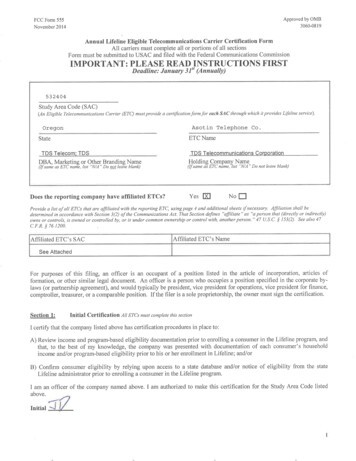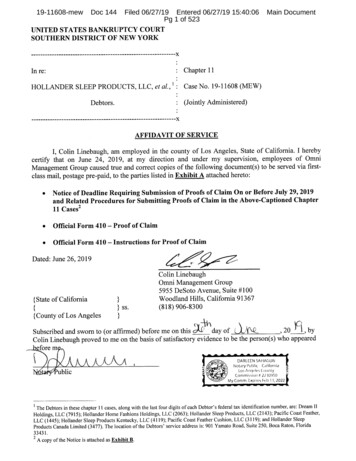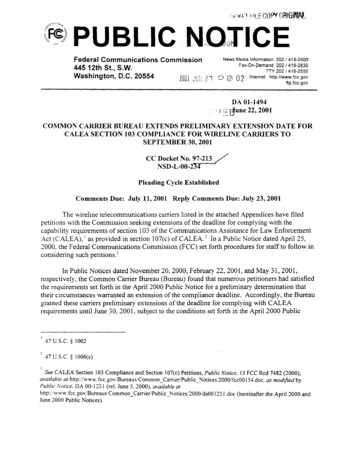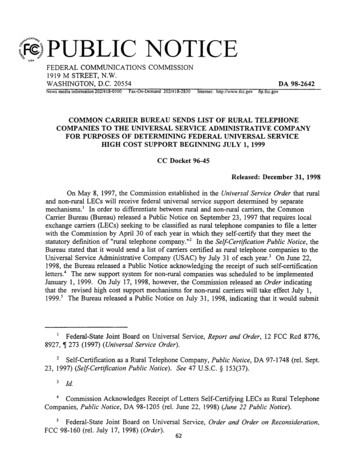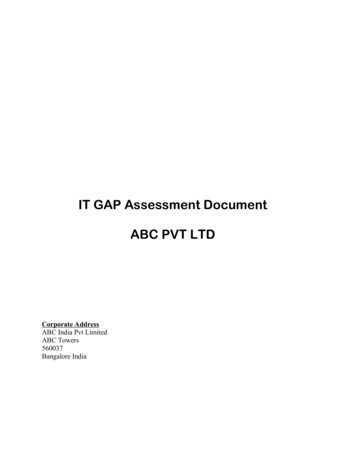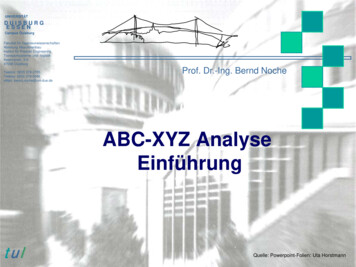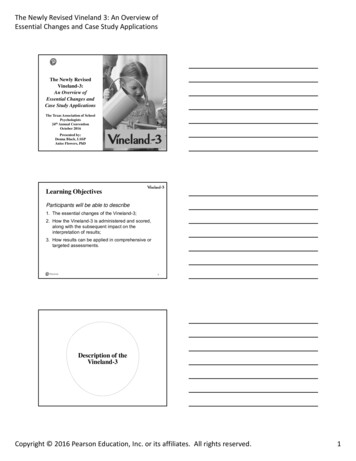
Transcription
BOUGHT WITH THE INCOMEFROM THESAGEENDOWMENTFUNDTHE GIFT OFficnrgM. Sage1891/ .? wj7-Sc O.-S/z./.l bJ-.7673-2
Cornell University LibraryarV18668ABC,.of the telephone:3 1924 031 291 945olin.anx
Cornell UniversityLibraryThetineoriginal oftliisbookis inCornell University Library.There are no known copyrightrestrictions inthe United States on the use of 91945
*'C/ N *--* t. UiU« ie
SECO/fHAJ I-D"RBVISE-D EUlTlOfiABCo/'CheTELEPHONEAPractical and Useful TreatiseforStudents and VTorKers in TelepKony,Giving a R.evievr o the Development ofthe Industry to the Present Date, and FullDescriptions o/ Numerous Valuable Inventions and Appliances, Together ith "V vY Many Illustrations, Dia ratesand Tables f'fi'9'fByJAMESE.HOMANS,THEO. AUDELA. M. i.CO., Publishers63 Fifth Ave., Cor. 13th St. N. Y.T
Copyrighted1901-1904BY&New YorkTheo. AudelCo.
PREFACE.In presenting a new edition ofnecessary only to repeat that the spherean elementary and generaltreatise;bookthisintended toit isstating themainwith the telephone industry in a clear and simple,asa goodWhileintroductionfill isfacts'itisthat ofconnectedstyle, so as to servea more extended study of the subject.tonot claimed that a perusal ofit isto the public,bookthiswill afford acom-plete education in all the details of telephone engineering, the informa-tion givenissufficiently fulland accurateto give the student an ideaof what he must learn, mostly by practical experience, in his subse-quent career.This second edition contains a number of features that were imperfectly treatedin thefirst.Several chapters have been rewrittenand enlarged with a view to rendering the book better adaptedforthe purposes of general referenceandnumber ofAmerican telephone manufacturerscases the products ofhave been noticed with credit.it isThis planimpossible to a iequately describegiving namesby the;also,practicalunmentioned, butpracticalmanyisinformation.this isManyafollowed solely becauseexcellent devices withoutbecause the names are frequently whatman.Iniswantedother devices of equal excellence aredue either to thefact that sufficiently clear
PREFACE.VIinformation could not be obtained, or that the scope of this booktoo limited to coverTheitiesthe field of invention in this department.author begs to thank several well-known telephone author-for courteousespeciallyallisassistance inthe preparation of thisbook;andMr. Charles E. Monroe, who has rendered very importantservice in selecting material,revising proofs,and in several sugges-tions of s interested in the subjects d inwillandbefuture
—CONTENTS.CHAPTER ONE.The Telephone Apparatus and————itsOperation.—The Telephone. Inventors of the Telephone. DerivationHow to use the Telephone.of the Word. The Apparatus.The Generator Box. The Generator. The Calling Current.The Hook Switch. The Receiver. The Transmitter and In-———xvii-xxivduction CoilCHAPTER TWO.ABrief Survey of the Theory of Sound, Necessary toAN Understanding op the Telephone.——The Transmutation of Energy. The Solar Spectrum. TheThe Qualities of Sounds. Octaves of Force.Reflected Sound; Resonance. Sound Waves. Movements ofSound Waves. Vowels and Consonants. Waves of a MovingString.How Sounds may be " Seen." Manometric Flames.The Human Voice. The Vocal Cords. Powers of theVoice. The Organs of Hearing. The Inner Ear. How DoWe Hear? The Sound Shaper. Voice PicturesMusical �—CHAPTER THREE.ABrief Survey of the Principles of Electricity.— Varieties of Electrical Force and—The Electric Circuit. — Electromotive Force, EMF. —The Voltaic—Activity a VoltaicCell.— Grotius' Theory of the Voltaic Cell.—The GalvanicCurrent; Dynamic Effects. — Resistance, Electrical and Mechan— Laws of Electrical Resistance. — " False Resistance."CEMF and Capacity. — Elements of Magnetism. — Electrical Induction. — Laws of Current Induction. —The Principles of ElecElectricitySource.Defined.— ElectricalCurrents.Cell.ical.ini-lS
—CONTENTS.viiiPAG&Force.— Magnets andMagneto-Electricity.— How the Dynamo Works.—The InducDimensions of Transformers. Windings of Transtion Coil.Linestro-Magnetism.— lephone CurrentsCHAPTER FOUR.Electrical Quantities.,Measurements.- Names of Electrical Units.—TheUse of Electrical Units.—The Ohm, the Unit of Resistance.—Electrical Pressure.—The Volt, the Unit of Pressure.—TheAmpere, the Unit of Current.— C. G. S. Units in Electricity.—Ohm's Law.—Water Currents and Electrical Currents. TheCoulomb, the Unit of Electrical Quantity. Ohm's Law Applied.— The Watt, the Unit of Power.—The Equivalent of theWatt.—Watts and Horse-Power.—The Joule, the Unit of Work.Resistance: Specific and Comparative. The Resistance UnitWire. Determining the Size from the Unit. Circuits: Seriesand Parallel.— The Farad, the Unit of Electrical Capacity.—Figures for Capacity in Pole Lines. The Henry, the Unit ofInductance. Neutralizing Self-induction by Capacity. PractiEffects of High Capaccal Methods of Neutralizing Capacity.».ity.Choking Coils in the .CHAPTER.39-58FIVE.History of the Speaking Telephone.—Reis' Receiver. — House's Telephone,— Drawbaugh's Claims. —Bell's Early Instruments. — Bell's First Permanent Magnet Receiver. — Superiorityof the Permanent Magnet. — Simplicity of the Magnet Telephone. — Prof. Bourseul's Prophecy. — Sensitiveness of the Magnet Telephone. — Siemens' Experiment. — Preece's Experiment.Reis'Telephone.Gray's Telephone.CHAPTER59-71SIX.Later Modifications of the Magnet Telephone.Conditions for Transmitting Speech.— Methods of Strengthening Magnet Receivers. Methods of Adjusting the Receiver.—.—The Siemens Telephone Receiver. —The N,euma"er Receiver.— Defects of Early Receivers. —Boxed CcmI Receivers. —Telephone Magnets, —Watch-Case Receivers. —The D'ArsonvalReceiver. —The Phelps Crown Receivers. —The GoloubitzkyReceiver. — The Ader Receiver73-84
—CONTENTS.IXPAGECHAPTER SEVEN.The Carbon Microphone Transmitter.Good Transmission.—The Theory of Varying— Berliner's Transmitter. — Edison's Carbon DiscTransmitter. — Hughes' Microphone. — Hunning's Dust Transmitter. —The Blake Transmitter. — Varieties of Carbon Transmitters. — Carbon Ball Transmitters. — Berliner's UniversalTransmitter. —The Solid Back Transmitter. — Improved Transmitters. —The Century Transmitter. — The Ericsson TransConditions forPressure.85-96mitterCHAPTER EIGHT.The Circuits of a Telephone Apparatus.Source of the Transmitter.— OpenCircuit BatCurrent Required.The Induction Coil. Action of the Induction Coil. Size ofTelephone Coils. An Alternating Transmitter. The Magneto-Generator Bell Call. Strength of the Current Generatedby the Magneto Call Generator. The Bell Magnet. ReElectricalteries.—DryCell sistance of the GeneratorCHAPTER NINE.The Switch Hook anditsFunction in the TelephoneApparatus.—The Automatic Cut-Out. The Attachment of the SwitchHook. " Hook Down " and " Hook Up." Generator CutOuts and Shunts. Familiar Shunting Devices. The Post Cut-————Out.—The Holteer-Cabot Shunt111 120CHAPTER TEN.The Switchboard and the Appliances of the Central Station.— Grounded and Metal——boards. —Circuits of a Grounded Line. — Switchboard Plugs.Grounded Switchboard; Operator's Circuits. — GroundedTelephone Systems, Large and Small.— The Switchboard;Construction and Operation.Making a Telephonic Connection. The Clear-out Drop.—The Circuits of a Switchboard. Grounded Line Switch-lic Circuits.its—Switchboard; Line Circuits. Metallic Circuit Switchboards;.Plug and Jack. Circuits of a Metallic Switchboard. MetallicSwitchboard; Operator's Circuits. Operation of the Switch—Key——121-135
—CONTENTS.XPAGBCHAPTERELEVEN".The Operator's Switch Keys and TelephoneSet.——Combined Listening and Ringing Keys. The Cook SwitchThe O'ConnellIts Operation.Its Construction.Key.Switch Key. Its Operation. The Couch and Seeley Key.Other Switch Keys.—The Switchboard Operator's TelephoneSets.The Switchboard Night Bell.— Switchboards for SrriallExchanges. Large Exchanges; Transferring Calls. Trunk136-148ing Connection———————CHAPTER TWELVE.Improved Switchboard Attachments.—Labor-Saving Devices. Combined Calling and Clearing-putThe Sterling Switchboard System. The SterlingDrop.— Sterling Jack and Plugs.—The Self-Restoring Drop.Circuits of a Self-RestoringIts Construction and Operation.Drop. Combined Drops and Jacks. Western Drop-Jack.Connecticut Drop-Jack.— Operation of the Ringing Circuit.Connecticut Switchboards.Its Night Bell Connections.149-164Couch and Seeley Drop- Jack. Kellogg Drop-JackDrops.———————CHAPTER THIRTEEN.Switchboard Lamp Signals and Circuits.Lamp Signals for Switchboards. — MethodsLamp Circuits. — Lamp Signals on the MainSignals Operated by Relays.— Jack andofMountingLine.— LampPlug Circuits165-170CHAPTER FOURTEEN.The Multiple Switchboard.of Large Exchanges. — The Arrangement—Varieties of Multiple Switchboards. —TheSeries Multiple Switchboard. —Testing Arrangements of a MulSwitchboard. —Test Circuits of a Series Switchboard.Method of Testing. —The Use of the Condenser in a Test Cir— Defects of a Series Multiple Switchboard. —The BranchTerminal Multiple Switchboard. — The Branch Terminal Testing Circuit. — Making a Test. —Visual "Busy" Signals. — Divided Multiple Switchboards. — Polarized Drops. —Answeringand Multiple Jacks. —Advantages of the SystemThe Requirementsof Multiple Jacks.tiple.cuit.171-187
—CONTENTS.XIPAGECHAPTER FIFTEEN.Locally Interconnected or Multiple Transfer Switchboard.—Objections to Multiple Switchboards. The Sabin-HamptonExpress System. Cut-Out Jacks. Rising Visual Signals.Call Boards and Order Boards.Operating the Call Boards.Operating the Order Boards. Lamp Signals and Relay CirOperation of the Signals. The Clear-Out Signal Syscuits.tem. The Signal System on an Out-Going Line. Advantagesof the Express System.The Cook-Beach Transfer System.Making a Connection. Operation of the Signal System.- TheWestern Express Transfer System. Operation of the System.189-201The Clear-Out TER SIXTEEN.Exchange Battery Systems.— Signaling Circuits and—Sources of Energy. — Connecting the Battery in Series. — Methods of Balancing the Cir—The Stone Central Battery System. —The Hayes CentralBattery System. — Of Repeating Coils. —The Dean-Carty Common Battery Arrangement. — Of Impedance or RetardationCoils. — Circuit Arrangements in the Dean System. —The Subscriber'sApparatus Circuits. — Improved Systems. — OtherMethods of Imparting Energy. — Systems Operating on Separate Circuits. — Dynamo Circuit and Thermopile. — Storage201-218Cells and Condensers. — Series Feed CircuitsAdvantagesBatteries.of a— CallingCommonaBattery.Subscriber.cuit.CHAPTER SEVENTEEN.Party Lines and Selective Signals.—The Series and Bridging—The Wiring of aSeries Apparatus. — Objections to the Series System. — MagnetoGenerators for Series—The Bridging Bell System.The Carty Bridging System. — Circuits of a Bridged Telephone.the Bell—Wiring of a Bridged Line. —High ImpedanceMagnets. —The Generators of Bridged Telephones. — InductionCoils Low Wound. — Independent Bridging Systems. — SelectParty Lines orSystems.—TheCommonSeriesCircuits.Methodof Wiring.Circuits.of
—CONTENTS.xii—— Thenals.— The— Step-by-Step Sig—The Pendulum Sig-PAGEStep-by-Step Principle.Transmission of Harmonic Waves.ive Systems.Transmitter. — Signaling by Current—A Two-Limb, Three-Circuit Signal.Six Signal Circuits to Two Wires. —The Principle of Quadruplex Telegraphy. —The Merits of Selective Signal Devices.nal.MetronomeStrength and Polarity.219-238Toll Lines.—Toll BoardsCHAPTER EIGHTEEN.TelephonePrivateSystems;andLinesCommon ntercommunicatingSystems.SignalReturn Circuits. Plug and Switch KeySignals.Wiring of a Common Battery Circuit. Wiring of anIndividual Battery Circuit.Ericsson IntercommunicatingSystem. Device to Insure Ringing of Signals. Mechanism ofthe Ness Hook. Operation of the Ness System. Wiring ofthe Ness Circuit.Common-Battery Intercommunicating SysDevices for——tems.—Common——————— Switch Circuits239-255CHAPTER NINETEEN.Private Telephone Lines and Intercommunicating Systems; Full Metallic Circuits.Full Metallic Circuits.—The CenturyMonroeSystemSwitch.—TheSwitch.—The PlummerCouch and Seeley Switch. Telephone—for Hotels257-266'CHAPTER TWENTY.Large Private Systems and Automatic Exchanges.—Limited Capacity of Private Telephone Systems. A PrivateSystem of Exceptional Size.Automatic Telephone Exchanges.—The Strowger Automatic System.— Subscriber's Circuit Making Apparatus.—The Clark Automatic Exchange267-272—CHAPTER TWENTY-ONE.Devices for Protecting Telephone Apparatus from Electrical Disturbances.Protectice Devices.— Fuse Wires.— Heat Coils and CircuitBreakers.—Tubular Fuses.— Lightning Arresters.— Line Protectives273-278
—CONTENTS-XlllPAGECHAPTER TWENTY-TWO.The General Conditions of Telephone Line Construction.—The Conditions of Line ConstrucDisturbances. — Inductive DisturbancesTelephone Lines. —The Electrostatic Conditions of279-284a Line. — Electrostatic Induction. — Electrostatic CapacityConstruction of Lines.General Inductivetion.—inCHAPTER TWENTY-THREE.Telephone Pole Lines.—Wood for Poles. —Preparing the—Cross Arms. —Attachments forthe Wires. — Spacing the Poles. — Planting the Poles. — GuyStubs and Anchor Logs. — Guy Wire and Cables. —Wire forTelephone Lines. —Wire Gauges. — Measuring Wire by Weight.— Stringing a Line. —Tension and Sag. — Drawing Out Wire.Attaching the Wires. — Splicing the Wires. — Sleeve Joints285-305Pole Line Construction.—DimensionsPoles.'of Poles.CHAPTER TWENTY-FOUR.Wire Transpositions on a PoleTranspositions—in Transposition. — TheTranspositions.Line.—on a Metallic Line. Method of MakingFrequency of Transpositions. General Rules—English Method of Transpositions306-312CHAPTER TWENTY-FIVE.Telephone Cables and Their UsePole Lines.Underground andin.—Testing— Separatingthe Circuits. — Method followed in Interior Work. —Underground Cable Construction. — Overhead Cable Construction.Separating and Connecting Cables. — Pole Terminals. — Exchange Terminals. — Arrangements for Different Circuits.Construction of Cables.—Twisted Pairs of Wires.and Connecting a Cable Line.Common—SplicingCables.Return Circuits313-323CHAPTER TWENTY-SIX.Circuit Balancing DBt icES.—Repeating—Dimensions—Arrangements of Repeating Coils.- Ef-Circuit Balancing Devices.of Repeating Coils.,fects ofRepeatingCoils.— Impedance orCoils.Retardation Coils324-330
—CONTENTS.XIVPAGECHAPTER TWENTY-SEVEN.The Microtelephone.—The Hand Microtelephone. AdvantagesForms of the Microtelephonephone.—of the Microtele-33 1 "333CHAPTER TWENTY-EIGHT.Wireless Telephony.The Preece Wireless Telephone.—TheThe Collins SystemBellRadiophone.,.334-33 CHAPTER TWENTY-NINE.Useful Definitions and Hints on Telephone Management.Definitions.Index—Telephone Troubles337-345347-349
ABCOFTHE TELEPHONE.CHAPTER ONE.THE TELEPHONE APPARATUS ANDITS OPERATION.—The Telephone. The telephone is an instrument for thetransmission of articulate speech by the electric current. So itwas described in the application and specifications on which, in1876, Alexander Graham Bell was granted letters patent for hismagnet telephone and because of this fortunate form of words,which covered the process as well as the device, he was able tomaintain a complete monopoly of the telephone business, until;the expiration of his patent rights, seventeen years later.—Inventors of the Telephone. Previous to the date ofpatent several experimenters had hit upon the idea oiBell'stransmitting sound by the electric currentElisha—butGreyasmust seem strange— amongthese persons regarded their instruments aslittlewastheseat the presentdayallmore thanor curiosities for exhibition purposes.Such,indeed, has been the experience of most of our e doubted their possibility, then theirconvinced of both only by practicalNow that the telephone has fully establishedat firstand weredemonstration.finallyclaim to attention, and become a useful, even indispensable,and other concerns of life, it is desirable thateveryone should have Some knowledge of its construction,operation and the theory upon vyhich it depends. To servesuch a purpose is the object of this book.its'article in business
A B C OF THE TELEPHONE.xviii—Derivation of the Word. The word, telephone, is formedfrom the two Greek words, tele, afar, and phonein, to sound, orto speak; and hence means the "far-speaker." Just so, wehave the word, telegraph, from tele and graphein, to write, withthe meaning, " far-writer," and telescope, from tele a nA skopein to see,wasmeaning "far-seer."in usemanyThe wordyears before Bell'svention; in fact, as early as 1820,in-whenCharles Wheatstone, one of the first experimenters on the theory of the electrictelegraph, used it as the name of hisdevice for transmitting the sound of thevoice to a considerable distance along awooden rod. This contrivance provedmore efficient than the "lovers' telegraph," as it was called, the simplestFig.I,—Usualform ofphoue Apparatus.Tele-form of acoustic telephone, consistingof two diaphragms closing, each an endof a tin can, connected by a taut string,which conveys the sound spoken intoeither can to the opposite end of theline.The "lovers' telegraph" wasdescribed in a book written by RobertHooke, an English scientist, as early as1667.—The Apparatus. The most familiar form of modern telephone apparatus is given in Fig. i, which shows its variousThese are a mounting-board bearing aparts to advantage.closed box at top and bottom, a call-bell apparatus of two gongsto be operated by a crank shown at the right of the upper box;the receiving instrument hanging on a forked hook at the left thetransmitting instrument mounted below on a "rocker arm"having an up and down movement.:;Howistonecessary,Use the Telephone.first,—Toto briskly turn theuse the apparatus itcrank at the right of the
THE TELEPHONE APPARATUS.XIXupper box. This causes the bells to ring, and also sends a current along the line, which calls the operator at the centralAfter " ringing up," remove the receiving instrument fromoffice.hook and applyhook relieved of the weightHaving applied thisinstrument to the ear, you will hear the " hello girl " at " central," asking, " what number ? "The names of all persons orfirms having telephones are printed in the " Telephone Directory," which is to be found at every station, and each namehas a number, by which the station may be called.Havingpreviously found the number of the person with whom you wishto converse, you give it by speaking into the transmitting instrument,never into the receiver.As soon as connections have been mad»between your line and his, in a mannerto be explained later, you begin theitsitto the ear; theof the receiver, immediately springs up.conversation, always speaking into theand hearing the answersfrom the other end through the receiver.On completing your conversation, youagain hang the receiver on the hook,which is pulled downward by theweight, and having done this, " ringoff " by a few rapid turns of the handle,again ringing the bells and thus informing " central " that you are throughtransmitterwith theThisFig. 2.—The Generatorshowing: Crank.Boxline.isa simple act, and one which some of us performmany hundred times in a year yet very few ever stop to considerhow delicate and complicated is the machinery used, or by what;wonderful, almost miraculous, processes the sound of the voiceisthus transmitted over a line of wire,maybea thousand mileslong.The Generator Box.—Togain some knowledge ofthevarious parts of a working telephone, in order that the readermay know of what we speak when each is described in detail,we will dissect an apparatus showing views of each separate
A B C OF THE TELEPHONE.XXcontrivance, and givingnames anduses.Thus, Fig.3showsalready seen attached to theupper end of the mounting-board in Fig. i. The door, asshown, opens on hinges at its right-hand edge, thus concealingthe crank of the call-bell previously mentioned.On the door,the interior of the boxjustback of thebellwe havegongs,istobe seen a small frame support-FiG. 3.— Interior of the generator box, showing the magneto-generator,switch-hook, and the magnets of the call bell.ing an object resembling an ordinary spool, or rather two ofThis is an electro-magnet, and its function is to ring thebell when an electric current is passed through it, on the sameprinciple as is seen in the electric door bell.them.—The Generator. The object within the box, which resembles three upright posts, is the magneto-generator, consistingofthreeThrough"horse-shoe" magnets, here shown in side view.their legs passes an " armature," a kind of metal reel
THE TELEPHONE ATPARATUS.wound about withWhena long coil of wire.means of the crank, previously mentioned, anproduced, or " generated," as the termfact, a small dynamo.TheCalling Current.—Thethis isThis machineis.one of the hinges;thence to the bell-magnet; thence backagain through a wire attached to theother hinge, and out upon the line wireitis,incur-tH a wire attached towhereturned byelectric current isrent passes from the generator throughto the central station,XXImoves aFig. 4.—Oneform of binding post.The screw at itsend is intended for contactwith the electrical conductor,and the line wire is inserted inthe hole through the centre,where it is held tight by thethumb screw.signal to inform the operator that yourstationiscalling.TheFig.5.two of theline wires are attached tobinding posts shown at the top of the box in Fig.—Single Pole Receiver,Shell made of hard rubber.to the binding posts at the tail end.2.Wires attached—The Hook Switch. Directly in front of the magnetogenerator is a lever, which passes through the side of the boxland ends in the forked hook supporting the receiving instruIt is known as the "hook-switch,"ment, as shown in Fig. i.and its use, as will be explained in a later chapter, is to switchthe talking instruments into circuit,position,andtogenerator again,whenitisinthe raisedbreak that circuit and switch in thewhen thereceiverisrestored toitscall-bellhook.—endThe Receiver. Fig. 5 represents the receiver. At onewe see two binding-posts to receive wires which connectwith the two binding-posts at theleftof therow ofsix that
A B COF THE TELEPHONE:XXltare p-aced directly beneath the generator-box.Tlie receiver isa magnet telephone of the kind invented and patented by Bell.Although many variations of the original instrument have sincebeen devised by experimenters and manufacturers, none haveimproved materially on the original.The other speakinginstrument, the transmitter, is made on a different principle. o. 6.—The Transmitter mounted on Rocker Arm,Induction Coil Box atattached to theits base.being a carbon microphone (or " sound-magnifier ") of the kinddevised by Mr. Edison.Both instruments, together withthe many variations and improvements, will be fully explainedin the proper place.We are at present concerned with theirfirstouter appearance, and the functions they serve in the practicaloperation of the apparatus.The Transmitter and Induction Coil.—Theusual formof the transmitter, enclosed in a semi-circular, or acylindricalcase, surmounted by a bell-shaped mouthpiece, andsupportedat theend of a movable arm,is shown in Fig. 6.Wires runbox at the base of the arm, and from thisagain other wires run from the four binding-posts shown inthefigure, through the back of the mounting-board, to theremain-fromitto the ironing four binding-posts of the six beneath the generator-box.
THE TELEPHONE APPARATUS.XXlllTheiron box contains an induction coil, a very useful andwonderful piece of apparatus, whose principles would require abook for discussion.Fig. 7 shows the form iasual to telephones.The connections of the four wires just mentioned mayFig.7.—Induction coil mounted in the base of transmitter arm,showing wiriug connections.be seen in Fig.8,twoat either end.Twoofthemare con-nected, through the transmitting instrument, with a voitaic, orbattery contained in the box' at the base of themounting-board, as shown in Fig. i. The Other two are directlychemical,Fl&. S. Section of transmitter arm and coil box, showing connectionsbetween the transmitter and induction coil.connected to the line wires and carry the current used in t:ansmitting the sounds spoken into the mouthpiece of the instrument.This brief description will give a good general idea ol
XXIVA B C OF THE TELEPHONE.various parts of an ordinary telephone apparatus.Tofully"understand the use of each one, and why all are " assembledinto one piece of machinery will involve a careful study of thewhole theory of the telephone. This study, as we shall see,For itwill require us to cover a wide range of scientific facts.is true that a complete understanding of telephony demands agood working knowledge of nearly every other branch ofelectrical industry.Pio. 9.—Form of Telephone Apparatus, manufactured in SwedenThe maznetogenerator and iaduction coU are enclosed in the box below the call bills; the bittervin the cupboard at the base of the backboard. The transmitter is mounted atthecells,top.
CHAPTER TWO.BRIEF SURVEY OF THE THEORY OF SOUND, NECESSARY TO AN UNDERSTANDING OF THE TELEPHONE.4The Transmutationvelous discoveries ofof Energy.modern—Amongscienceiswhatmany marknown as thetheis"transmutation " of energy or force, that is, the fact that oneforce may under the proper conditions be changed into any"Transmutation" means " changing about. " Thusother.heat may be transformed into electrical activity and chemicalHeat mayenergies may become either the one or the other.result from friction (rubbing), or from chemical action, as wpsee in fire, where the process by which a substance is reducedAgain heat, and light also,to ashes is called "combustion."In short, scientists tell us that heat,result from electricity.light and sound are all one and the same thing, differing onlyThus, when we feel that a body is hot, warm orin degree.or when we see that lightwhen we hear a sound, and knowbright or dim ; orloud or indistinct, ordiffers from other sounds in representing a different musicalnote we are only perceiving one fact, under different forms, andcoldby;it isdifferent senses.to be found—A goodby comparing the octaveThe Solar Spectrunn.isis brilliant,thatillustration of this factof a musical instrumentwith the solar spectrum, as seen in a rainbow, or when sunlightVery different things Indeed theseshines through a prism.may seem to niost observers, but science compares them. The—shows seven colors violet, indigo, blue, green,in a row in the order given. But thesecolors are not sharply Separated from one another so that, forexample, we have blue on one side of a line and green on theother; they seem to melt into one another, passing through all thepossible shades and tints of each color. Further, we have violet atsolar spectrumyellow, orange and red—I
A B C OF THE TELEPHONE.2and red at the other.Now we know thatproduced by a proper blending of shades ofred with shades of blue. Thus violet and indigo stand in theseries between red and blue, jugt as green stands between, andis to be made by a blending of, blue and -yellow, and orangestands between yellow and red.From these facts, we mayunderstand what scientists mean when they say that the solaror light, spectrum is only one of a series of spectrums, eachbeginning with violet or what corresponds to it in some otherform of force, and ending with red.one end of thelinein the arts violetis—The Musical Scale'. Now, turning to the musical scale,we have a fact precisely similar to the spectrum. Here wehave another series of seven; sounds, which musicians nameA,' By C, D, Ey F, G, so that whenever we run over the notes inorder, we find that every eighth note is the same sound as theone We began with, only higher or lower, nearer the bass ortt-eble, as the case may be.Now, we have beside the seven" naturals, " as musicians call them, five other notes called halftones or "sharps" and "flats" thus, "B" sharp is "A''flat and, furthermore, certain delicate instruments used byexperimenters have demonstrated the fact that each simple note,as we suppose it to be, is in reality a bundle or collection ofmany separate tones or sounds, differing in pitch and also iq— loudness.—TheQualities of Sounds. The pitch of each separateaffects the ear, is, in' reality, only the pitch of thegravest and loudest of the collection, and it is called the" fundamental. " The other sounds are called the " overtones "or "harmonics" and these,' mingling with the fundamental-,give the timbre or quality of the note, although, when we speakof timbre, we carinot by the ear separate the individual notes,note, asitwhich combine to produce its character, pleasing or displeasing.These overtones we mdy compare to the succession of shades bywhich one color of the spectrum passes almost imperceptiblyiiitoanother, even while not interfering with the eye's sensation
THE THEORY OF SOUND.3In one kind of instrument, such as the piano,of seven colors.we have one setwe have anotherand in another, such as the violin,and it is this fact that gives the characteristic difference between a piano and a violin note, although the" fundamentals " may be the same in both. Thus in a musicalintensified,set;note the ear finds three thingsor tone,andits—the loudness of the note,itspitchtimbre or quality.—Octaves of Force. Having thus demonstrated that lightboth follow one and the same law, scientists concludesoundandInthat both are manifestations of the one force in nature.other words they find that both are forces, manifestations ofvibration in the air, in solid bodies, or in the finer "ether"which is
boughtwiththeincome fromthe sageendowmentfund thegiftof ficnrgm.sage 1891 / .? wj7-sc o.-s/z./.l bj-. 7673-2


